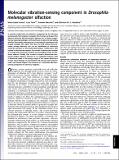| dc.contributor.author | Mershin, Andreas | |
| dc.contributor.author | Turina, Luca | |
| dc.contributor.author | Franco, Maria Isabel | |
| dc.contributor.author | Skoulakis, Efthimios M. C. | |
| dc.date.accessioned | 2011-10-19T18:50:47Z | |
| dc.date.available | 2011-10-19T18:50:47Z | |
| dc.date.issued | 2011-01 | |
| dc.date.submitted | 2010-08 | |
| dc.identifier.issn | 0027-8424 | |
| dc.identifier.issn | 1091-6490 | |
| dc.identifier.uri | http://hdl.handle.net/1721.1/66499 | |
| dc.description.abstract | A common explanation of molecular recognition by the olfactory system posits that receptors recognize the structure or shape of the odorant molecule. We performed a rigorous test of shape recognition by replacing hydrogen with deuterium in odorants and asking whether Drosophila melanogaster can distinguish these identically shaped isotopes. We report that flies not only differentiate between isotopic odorants, but can be conditioned to selectively avoid the common or the deuterated isotope. Furthermore, flies trained to discriminate against the normal or deuterated isotopes of a compound, selectively avoid the corresponding isotope of a different odorant. Finally, flies trained to avoid a deuterated compound exhibit selective aversion to an unrelated molecule with a vibrational mode in the energy range of the carbon–deuterium stretch. These findings are inconsistent with a shape-only model for smell, and instead support the existence of a molecular vibration-sensing component to olfactory reception. | en_US |
| dc.description.sponsorship | United States. Defense Advanced Research Projects Agency (Grant N66001-10-1-4062) | en_US |
| dc.language.iso | en_US | |
| dc.publisher | National Academy of Sciences | en_US |
| dc.relation.isversionof | http://dx.doi.org/10.1073/pnas.1012293108 | en_US |
| dc.rights | Article is made available in accordance with the publisher's policy and may be subject to US copyright law. Please refer to the publisher's site for terms of use. | en_US |
| dc.source | PNAS | en_US |
| dc.title | Molecular vibration-sensing component in Drosophila melanogaster olfaction | en_US |
| dc.type | Article | en_US |
| dc.identifier.citation | Franco, M. I. et al. “Molecular vibration-sensing component in Drosophila melanogaster olfaction.” Proceedings of the National Academy of Sciences 108 (2011): 3797-3802. Web. 19 Oct. 2011. © 2011 by the National Academy of Sciences | en_US |
| dc.contributor.department | Massachusetts Institute of Technology. Center for Biomedical Engineering | en_US |
| dc.contributor.department | Massachusetts Institute of Technology. Media Laboratory | en_US |
| dc.contributor.approver | Mershin, Andreas | |
| dc.contributor.mitauthor | Mershin, Andreas | |
| dc.contributor.mitauthor | Turina, Luca | |
| dc.relation.journal | Proceedings of the National Academy of Sciences of the United States of America | en_US |
| dc.eprint.version | Final published version | en_US |
| dc.type.uri | http://purl.org/eprint/type/JournalArticle | en_US |
| eprint.status | http://purl.org/eprint/status/PeerReviewed | en_US |
| dspace.orderedauthors | Franco, M. I.; Turin, L.; Mershin, A.; Skoulakis, E. M. C. | en |
| mit.license | PUBLISHER_POLICY | en_US |
| mit.metadata.status | Complete | |
